Dr. Phil Zeltzman’s Blog
What you need to know about broken bones
We repair a surprisingly large number of fractured bones (aka broken bones).
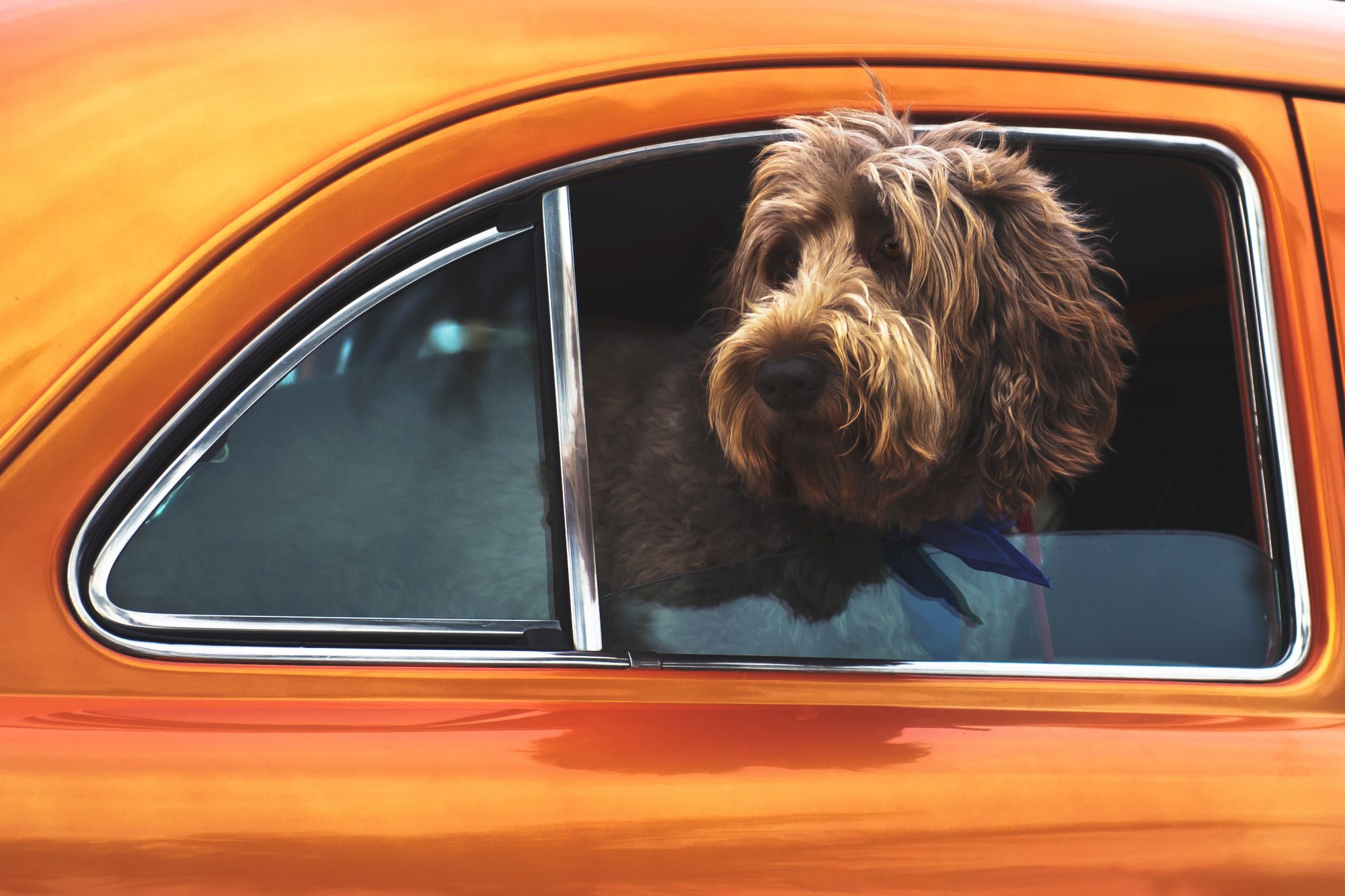
They can happen at any age. We’ve surgically treated a 3 week old pup and a 23 year old kitty.
Virtually any bone in the body can sustain a fracture: skull, vertebrae, legs, pelvis, tail, ribs… no bone is spared!
Just in the past 3 weeks, we’ve had:
. 3 dogs who jumped out of the car window
. 1 dog who jumped off the couch
. 1 dog who was attacked by another one.
. 1 dog who was hit by a car.
And that’s just in 3 weeks!
This blog was written to:
. inform you about how fractures happen.
. tell you how they are commonly repaired.
. help you prevent them.
How do bone fractures happen?
Here are the top 10 reasons (in no particular order):
Falls
Cancer
Gunshot
Hit by car
Fights/Bites
Malformation
Jaw – Bad teeth
Bone deterioration
Fatigue (repeated trauma)
Various traumas (slipping on ice…)

How do we repair bone fractures?
There are multiple types of fractures and multiple ways to repair them. Let’s go over the most common ways.
But wait, not all fractures need surgery.
Some will simply heal with rest, time and pain medication.
Occasionally, healing can be attempted with a splint – a type of bandage reinforced with a molded piece of plastic (I am not too fond of casts…).
The challenge is to know which fractures can predictably heal with a splint.
For example, fractures of the forearm (radius & ulna) and shin bone (tibia & fibula) in small dogs don’t heal well with a splint, and most need surgery. This is a common misconception.
Many fractures require surgery.
There are 2 main ways to fix a fracture:
. with internal fixation, where no implant can be seen outside the skin.
. with external fixation, meaning that the implants are visible from the outside. This is called an external fixator.
- Plates and screws
The most common type of repair involves a bone plate and some screws. A plate is a flat stainless steel bar with holes, designed to keep the pieces of bone together while the fracture heals. The plate is attached to the bone with stainless steel screws.
Plates have different shapes, thicknesses, widths and lengths. The number of screw holes varies accordingly.
So a Yorkie with a forearm (radius) fracture may need a small 6-hole plate, and a Lab with a complicated thigh bone (femur) fracture may need a big 12-hole plate.
Therefore, a surgery practice must stock a variety of plates, since we need to be prepared to help a kitten as well as a Great Dane.
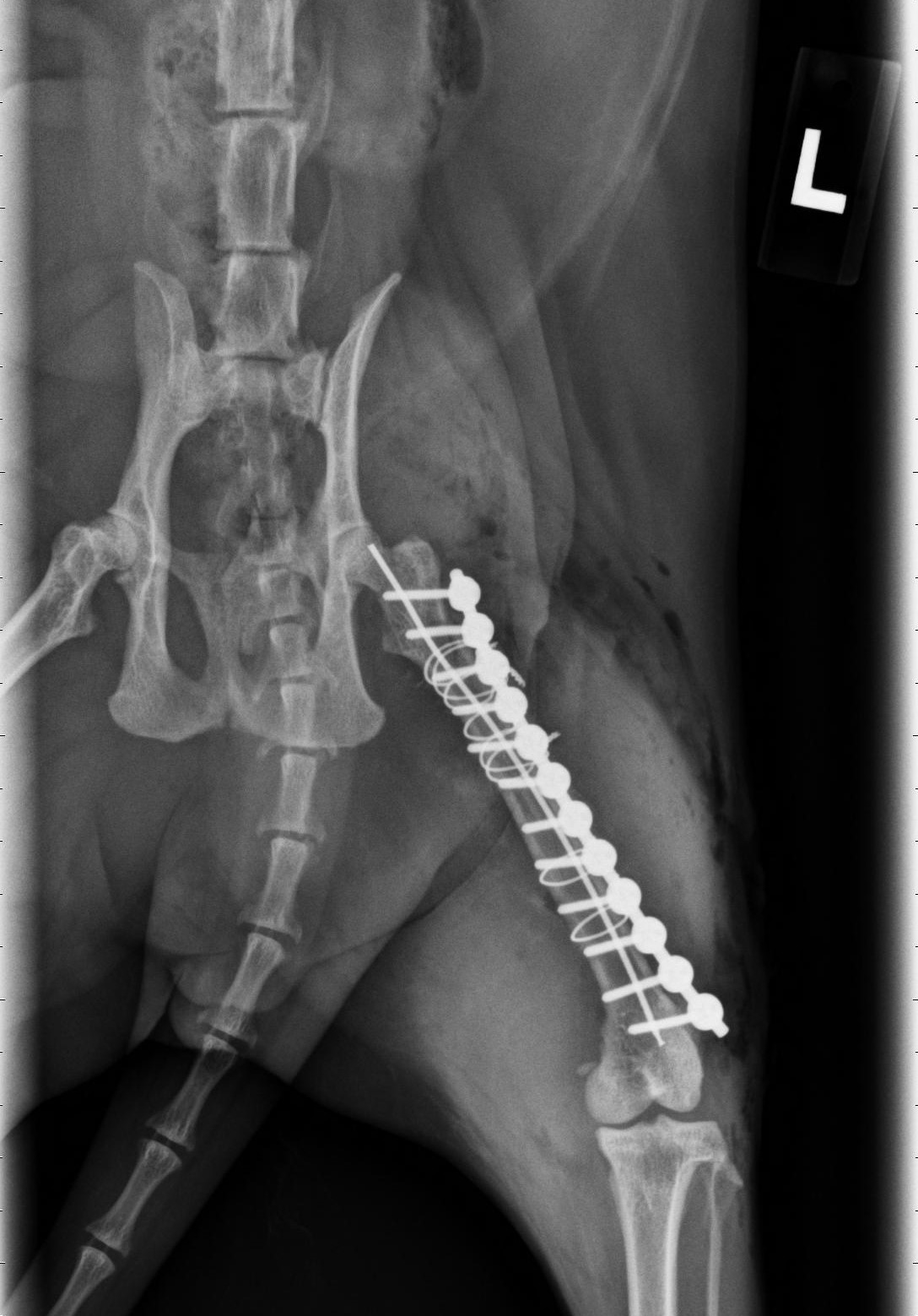
- Wires
To help reconstruct a bone that is in several pieces, we sometimes need the help of stainless steel wire (“cerclage wire”).
Some wire is placed around pieces of bone, and the ends are twisted, like a twisty-tie on your bread.
- Pins
Pins look like knitting needles. They come in various lengths and sizes.
They are used to connect one piece of bone to another. Pins are used in very specific cases, either to reinforce a plate and screw repair (see above), or as the main repair (see below).
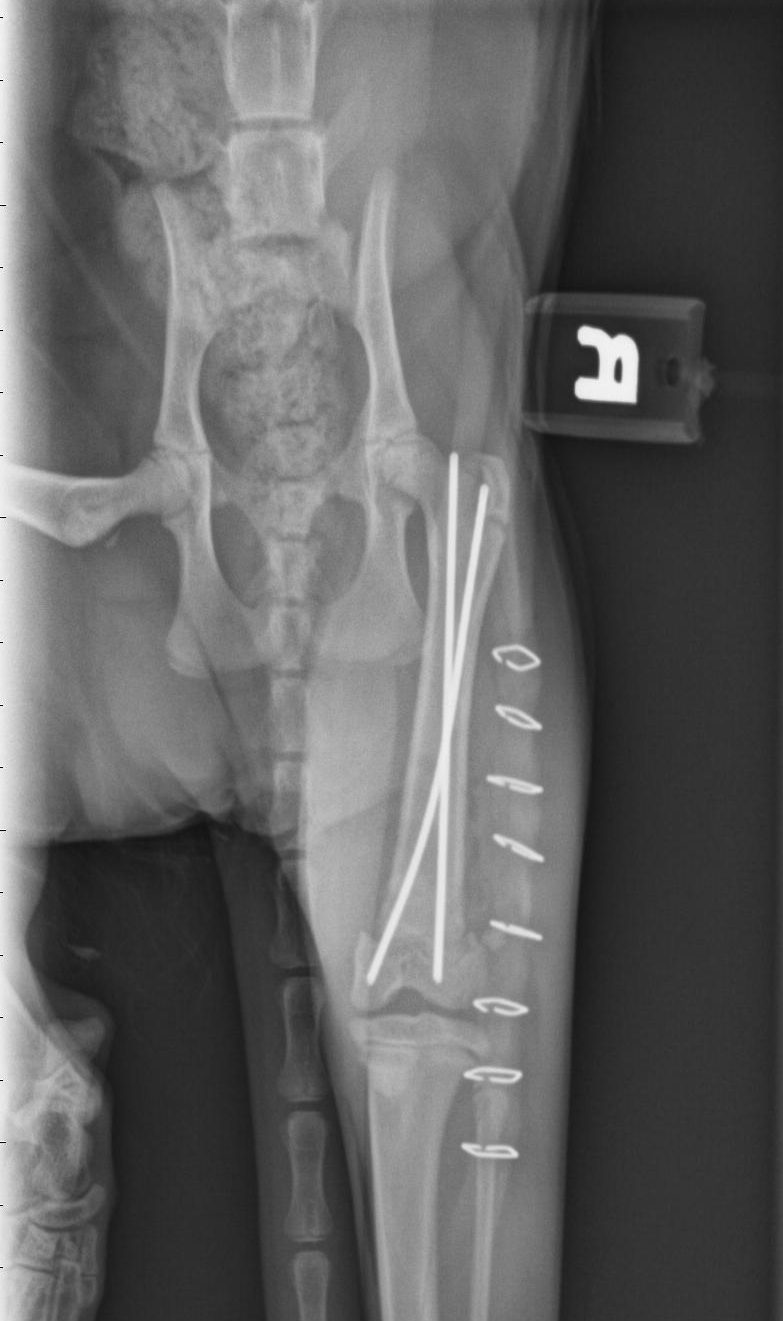
Again, all the implants described above are used under the skin, so they are used for “internal fixation.” Once the surgeon is done, the skin is sutured, and you can’t see anything stick out. These implants are typically designed to stay in forever. Only if they cause problem would we remove them.
- External fixators
In some cases, such as bad gunshot wounds, we prefer using “external fixation.”
There are different types of external fixators, but here is the concept: several pins are placed through the skin, into the broken pieces of bone.
Then a big metal bar, or some other device, is used to connect all the pins. By keeping the pins together, we indirectly keep the pieces of bone aligned, which helps them heal.
To avoid infection, the holes in the skin must be cleaned regularly, e.g. with hydrogen peroxide.
Because it is external to the skin, the fixator must be removed after the fracture is healed. This is typically a quick procedure under heavy sedation or brief anesthesia.
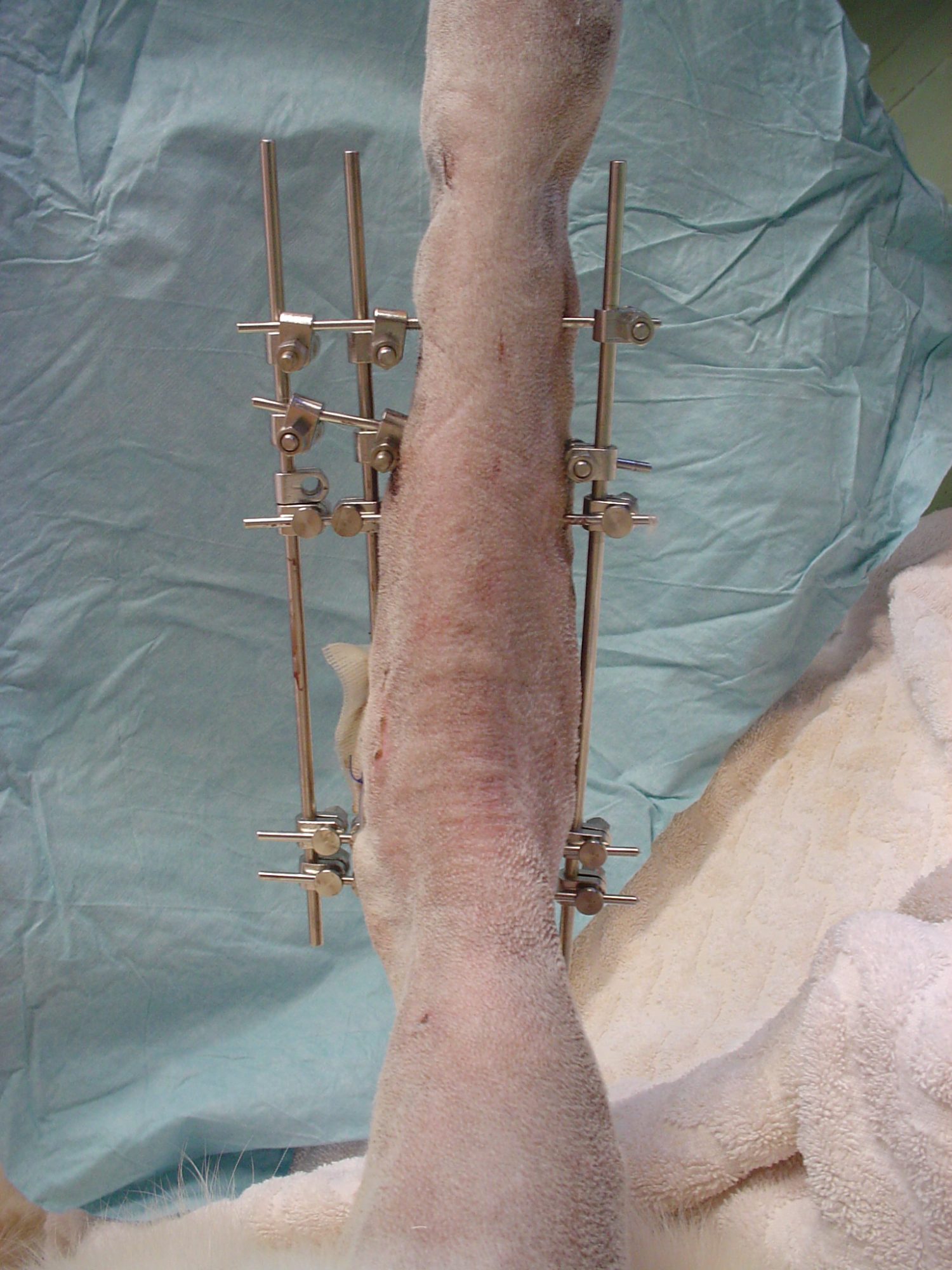
How can you prevent bone fractures?
As always, prevention is the best medicine. Not every fracture can be prevented. Accidents do happen.
Some dogs sustain a fracture while playing in the back yard. Some cats get a fracture while playing indoors. As sad as it is, that is nobody’s fault and simply cannot be avoided.
Many could have been prevented. Several easy ways come to mind:
– Keep your dog on a leash when outdoors to decrease the risk of getting into a fight or being hit by a car.
– Keep cats indoors.
– Keep dogs inside a fenced-in yard.
– Don’t let small dogs jump from your arms or furniture. They can get very common fractures of the forearm or the elbow.
– Never let your car windows open to allow your dog to enjoy the wind and the smells. Remember, we saw 3 dogs who jumped from a car window in the past 3 weeks. All 3 owners swore that they had done it multiple times and they had never jumped before. Which is true… until they did.
Fractures can be painful both to the patient and the owner’s finances. Luckily, most fractures can be repaired and most pets can ultimately lead a normal, happy, comfortable life.

Postop care:
Depending on the fracture, the type of repair and the pet, you might need:
. very strict confinement, on ground zero, in a large crate or a small room, most often for 2 months.
. weekly splint changes if needed.
. regular X-rays to assess healing of the bone.
. pain medications and antibiotics.
. short leash walks for elimination only (for dogs).
. rehab once the bone has healed, to transition to normal life.
Then they can go back to their interrupted agenda: the squirrel herder, the keeper of the couch, the bird chaser, the flower bed destroyer or the overall ruler of the back yard.
Phil Zeltzman, DVM, DACVS, CVJ, Fear Free Certified

Dr. Phil Zeltzman is a traveling veterinary surgeon in Pennsylvania & New Jersey. An award-winning author, he loves to share his adventures in practice along with information about vet medicine and surgery that can really help your pets. Dr. Zeltzman specializes in orthopedic, neurologic, cancer, and soft tissue surgeries for dogs, cats, and small exotics. By working with local family vets, he offers the best surgical care, safest anesthesia, and utmost pain management to all his patients. Sign up to get an email when he updates his blog, and follow him on Facebook, too!
Valentine, the rescued kitten with a broken leg
Valentine, a 7 month old kitten, was rescued after someone noticed that he (yes he’s a boy), that he was not putting any weight on his right back leg. X-rays showed that he had a fracture at the very end of the right thigh bone (see X-ray below).
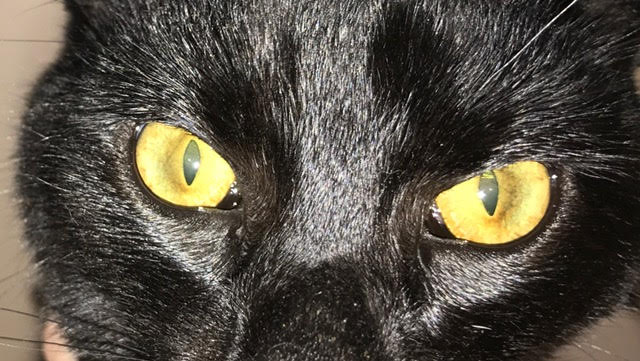
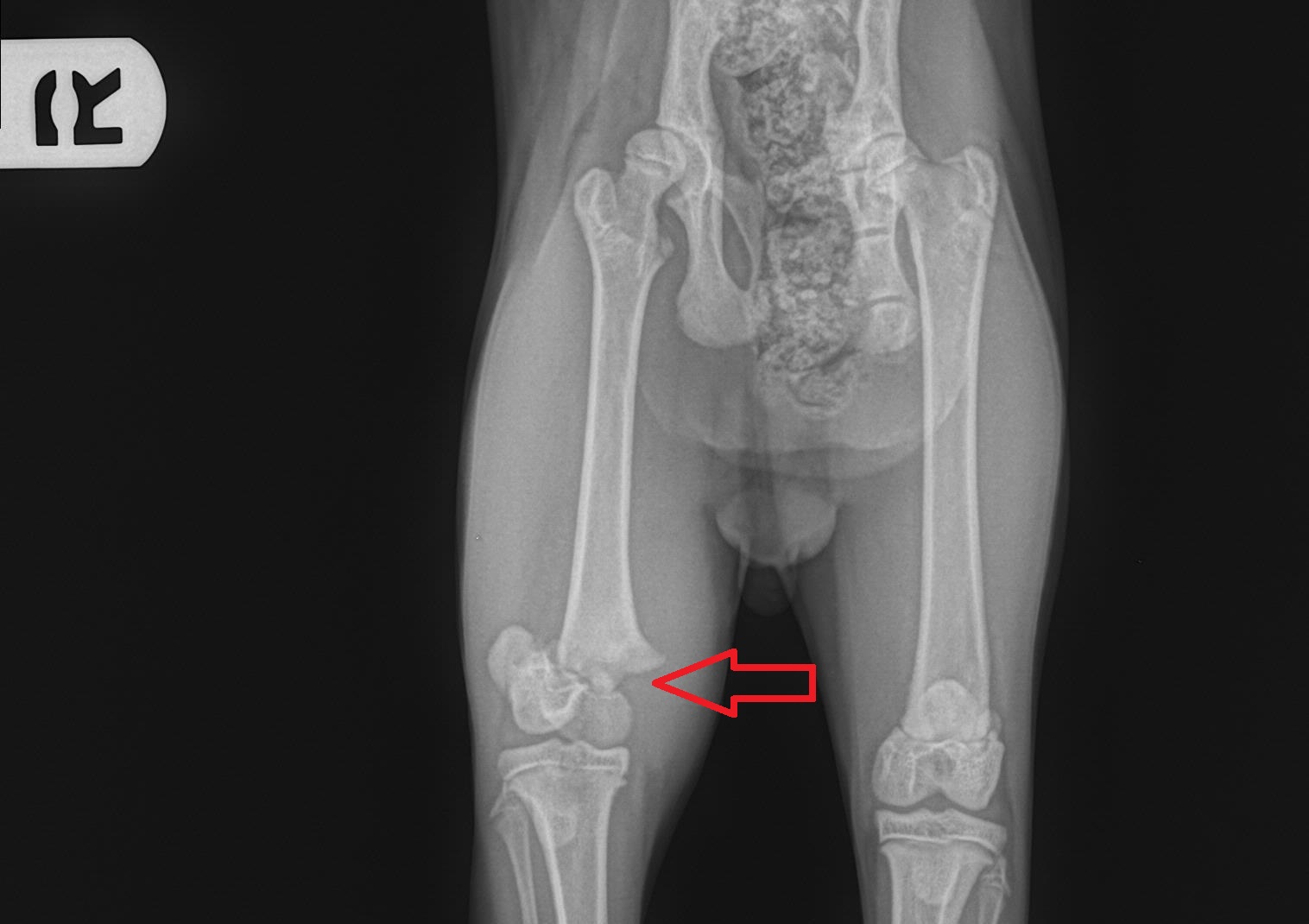
An exam showed that the bone had already healed. Yet the X-ray showed that the bone was grossly misaligned (see red arrow).
So we took Valentine to surgery with 2 options in mind:
. If the fracture could be repaired nicely, then we would fix the bone.
. If a good outcome could not be reached, we would sacrifice the leg (a nice way to say that we would amputate the leg).
In surgery, I confirmed that the bone had healed in a crooked way. The kneecap was completely dislocated as a consequence. We had to “rebreak the bone”. I then removed a bunch of scar tissue, realigned the bone, and repaired it with 4 metal pins (see postop X-ray below).
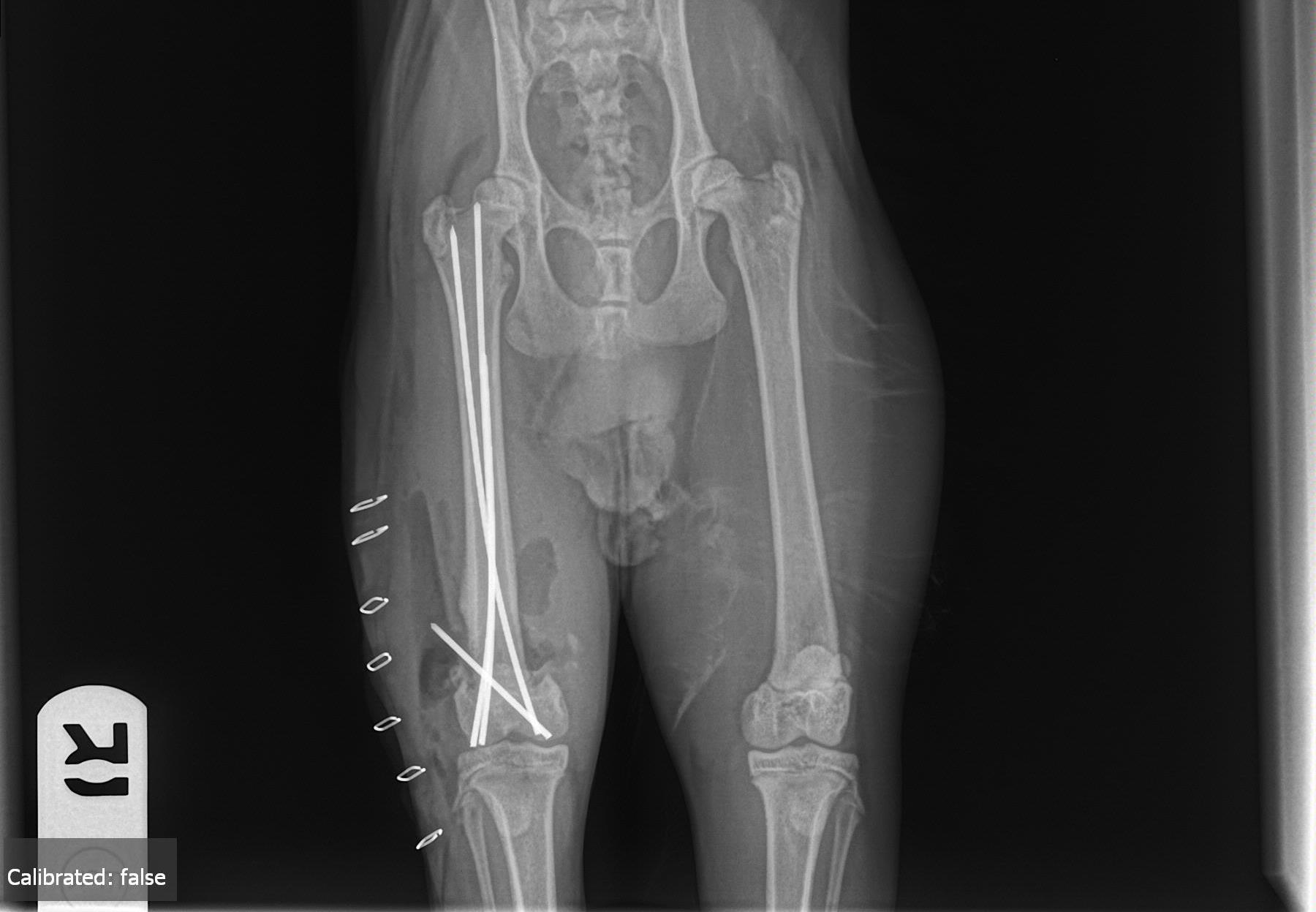
Then I repaired the dislocated kneecap.
After 6 weeks of strict rest and physical therapy, Valentine should be able to find a furever home and enjoy a happy life.

Dr. Phil Zeltzman is a traveling veterinary surgeon in Pennsylvania & New Jersey. An award-winning author, he loves to share his adventures in practice along with information about vet medicine and surgery that can really help your pets. Dr. Zeltzman specializes in orthopedic, neurologic, cancer, and soft tissue surgeries for dogs, cats, and small exotics. By working with local family vets, he offers the best surgical care, safest anesthesia, and utmost pain management to all his patients. Sign up to get an email when he updates his blog, and follow him on Facebook, too!

